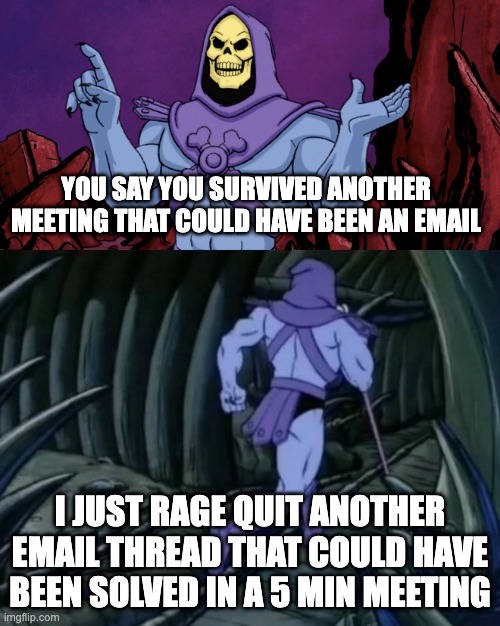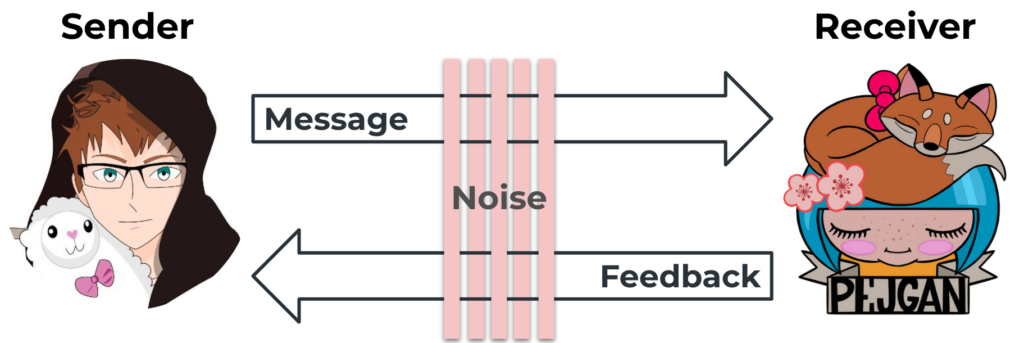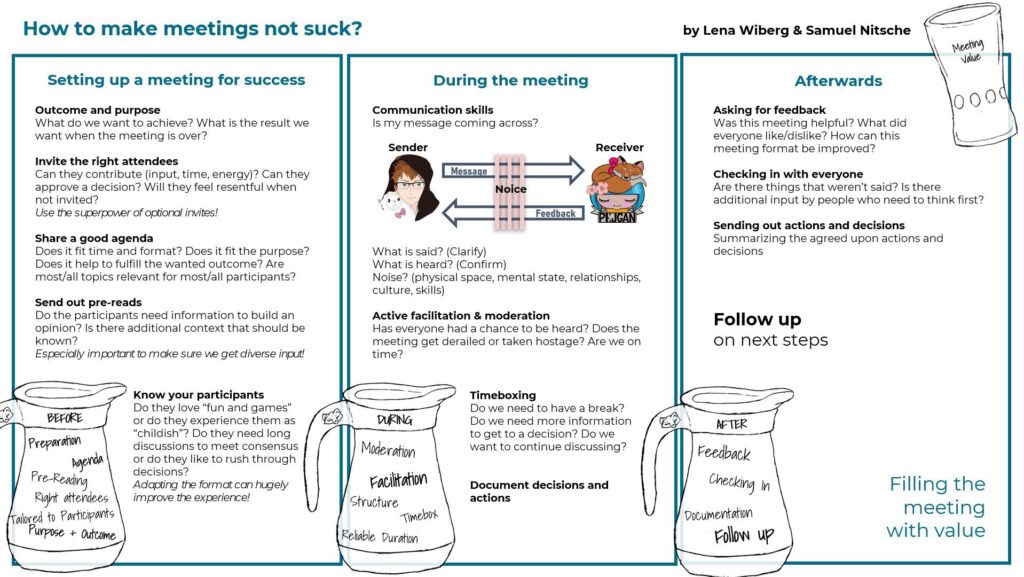(Note: This is a follow up/deep dive from this post)
A lot of people hate meetings and claim all (or most) meetings are waste of time. While I certainly agree there are a lot of unnecessary meetings out there – the problem with most of them is the way we do them. We don’t plan and prepare, we invite the wrong people and we don’t learn from them.
There are a lot of meetings that should not have been a meeting. That does not mean nothing should be a meeting. A meeting is simply defined by Google/Oxford Language as ”an assembly of people for a particular purpose, especially for formal discussion”. Unless you plan to spend your days not collaborating with people or need other people’s input, you will at some point need a meeting. I promise you, endless email threads or non-documented discussions in one of endless Slack channels won’t cut it for everything.

Let’s go through some important parts of a meeting and try to explain how you could make your meetings feel less like waste and actually bring proper value.
Before – Setting the meeting up for success
There are a number of things to do before the meeting is actually held.
Deciding a purpose and a wanted outcome
First of all you should make sure you know why you are having the meeting and what you hope to come out of it. ”But Lena, a meeting is a meeting!” you might be thinking. I say no.
Meetings can have different purposes, such as :
- Decision-making meetings. When an action needs to be taken by a group.
- Problem-solving meetings. When a group needs to come together to solve a problem.
- Team-building meetings. Used to build cohesion within a group and improve the way team members work together.
- Brainstorming meetings. Used to generate new ideas or make links between novel or innovative concepts.
- One-on-one meetings. A meeting between two people, often periodically recurring
- Planning meetings. Held regularly, used to plan how a team will execute the company’s goals.
- Syncing/Check-in meetings. Used to monitor task progress against an expected outcome.
- Workshops
- Discussion forum
- Knowledge sharing / craft forum / Brown bag sessions
The purpose should guide the rest of your preparations so start of there.
Depending on your purpose you will also likely have different wanted outcomes. For a decision making meeting you likely want to end up with either a decision or knowledge of what to do to get to the decision. For a team-building meeting you likely expect to have learned more about the attendees and perhaps built some stronger relationships. For a brainstorming meeting you likely want to end up with a lot of ideas and perhaps even have picked a few to move forward with.
If you don’t know why you are having the meeting and what you want from it – you are very likely not to get anything valuable from it.
Inviting the right attendees
Next up is to decide who should be in the meeting. The attendees should be able to contribute to the wanted outcome and, unless it’s purely relaying of information, be a small enough group not to hinder active participation. For the ideal meeting you want people who want to be part, have time and energy to participate and will have important input.
For a decision meeting – you need the people who can make the decision. A decision meeting without the person needed to make a decision will not give you any wanted outcome.
For a brainstorming session you want as many different perspectives as possible, not a homogenous group with similar ideas.
For a planning meeting you need people who have insights into the things you are planning, so you don’t miss important pieces.
For a team building exercise you need… the team.
Usually a good size of a meeting is similar to ideal size of a team, somewhere perhaps 3-9 (depending on who you ask). Bigger than nine will make the meeting less efficient, smaller than 3 is typically too small for most purposes. The number of lines of communication grow fast when adding people to a group and it becomes harder to make everyone seen, listened to and – be a valuable participant.

If you have people who would be nice to have, might get offended by not being invited or something similar – Invite them as optional. Optional invites are great! It shows you are welcoming and open but also shows people you have considered if they are needed or not and it also makes it easier for people who need to prioritise.
When you have a chosen set of participants, think a bit about what they are like and what they would like. Some people will love “fun and games”, some will get stressed by it. Some people need long discussions to meet consensus, some want to just rush through decisions. Knowing the participants and adapt the format to them will increase the value they, and you, get from it. Use this information in the next step.
Create a format and an agenda
When you know the why and the who – it’s time to start looking at a suitable format and an agenda.
The format can be guided from a number of things: how much time will you have/can you set aside? Where, location wise, will you be and does that come with limitations?
And what would likely fit the participants? Nothing can derail a meeting as fast as not using a suitable format. If you try to get a bunch of people who expect to be making fast decision to build towers of sugar cubes – they will likely not be happy. But on the other hand, if you have a group that are open to games, games is a fantastic way of getting the creativity flowing! Just… try to read the room, ok?
The agenda should
- Fit the format, the limitations and the time allocated.
Don’t try to squeeze ten totally different topics into a single meeting and then have to rush through or always end up with half the agenda left when the time runs out. - Fits the purpose and has a chance of giving you the wanted outcome
- Has topics that are relevant for all participants.
If you have ten topics and half of them are only relevant to a sub group – that’s multiple meetings.
Prepare your attendees
Ok, we are almost ready to rock. By know you hopefully have a set of people, you know what you want to achieve and you have found a time and a place to do it. (This is not an article around google calendar or outlook unfortunately. You will need to look elsewhere for tips on how to work the calendar)
Before you go though, I want you to do one last thing: Send out pre-reading material. And no, I don’t mean just making sure the meeting invite includes the purpose, the expected outcome and the agenda, I mean actually setting your participants up for maximum participation.
(But… please do make sure the meeting invite includes the purpose, the expected outcome and the agenda! Please)
Pre-reading material is any information that participants will need to have an opinion about in the meeting. Like background to a certain decision. Different options that are being considered. For some reason a lot of people don’t do this and I don’t really know why. Is it because we want stuff to be surprises? Is it to get spontaneous discussions and ”top of your mind” thoughts? I don’t know. But I do know this favours a certain type of people and means you will end up with less diverse input.
The people who are comfortable having opinions with little preparation, on the spot, are not smarter or have better opinions. But we tend to give them more space, better career progression and view them as more important team members. I promise, if you give people the time and space to reflect, you will find other voices bringing just as much value. Pre-reads. Do it.
During
Communication skills
If you want to maximise the chances of your message coming across as you want – good communication skills are crucial. Just because you believe said something does not mean that is what people actually hear. And worse – not what they will interpret your meaning as.
There is a difference between
- What I meant to say
- What I actually said
- What the receiver heard
- What the receiver interpreted it as
Things that can affect the interpretation can be
- What is being said – which words
- How we say it – tone of voice, body language
- Noise, such as physical space, mental state, cultural differences, social skills
- Your relationship to each other
To overcome this, make sure to use basic things such as asking the receiver to confirm what they heard, clarifying the message you are sending and assuming good intent.

Active facilitation
As meeting leader, it’s important we take active responsibility for facilitating the meeting to make sure we optimise for meeting our wanted outcome. This includes things like
- Making sure to give everyone a change to be heard
- Taking charge of the meeting if it is derailed or taken hostage
- Making sure decisions and actions are documented by someone
- Keeping track of time
Timeboxing
If you end up with discussions that drag on for too long it is important you are on top of it. Either you actively decide the discussions are important enough for other agenda points to not get covered, or you take charge and stop the discussion to move to the next point. This can be very uncomfortable but gets easier with time.
Working with bad actors
Unfortunately, sometimes we have to deal with bad actors. This can for example be
- Someone who has their own agenda
- Someone who does not want to accept a decision
- Someone who interrupts people
- Someone who keeps using inappropriate language
Depending on the problem, the person or even your own standing in the group, it can be very easy or almost impossible to deal with. But remember, it is your meeting and you are responsible for it. If you can, it is great if you can stop the person in the act. Maybe by kindly moving the discussion forward, asking them to take the discussion elsewhere, acknowledging that you are seeing that someone is interrupting or stealing someone else’s ideas or saying out loud ”This is not a language we use in this group. We don’t treat each other that way”. Often that is enough. If it isn’t, feel free to abort the meeting and ask for help from someone, perhaps a manager or HR.
Documentation
Make sure to not trust your memory. Document any decisions, actions agreed on, problems or questions you need to solve and next steps. Since you will likely be busy moderating, give someone the task of documenting so you can focus. For A plus – also set someone responsible and when it needs to be followed up on.
After
Asking for feedback
You don’t know if your meeting went well unless you ask. Make it a habit to always ask for feedback. There is always something to improve! Either do it as a check-out exercise or do it afterwards. (Anonymous will help getting honest opinions)
Send out documentation
You took the time to document things. Make sure to clean it up and send it out. Extra important – the people who are expected to do something, make sure they know it and remind them.
Check in with people
If you have noticed someone was not sharing as much or seemed less active – check in with them afterwards! You will get some fantastic ideas and opinions this way.
Follow up on actions and next steps
And now we are almost done. The only thing left to do is to make sure all of this effort is not lost. Make sure to follow up on the actions you decided on, see that next steps happen and use the feedback you gathered to do an even better meeting next time!
TL;DR
”Lena. Ain’t no one have time to do all this! I have ten meetings every day! Give me a quick fix!”
Well. *uncomfortable silence*
Good news: Not all meetings are as important, as hard or need as much. You don’t have to spend all this energy on the meetings that are already working or meetings that you don’t think could have any big impact even if you change them. (Maybe remove a few of them and replace them with Slack or email?)
Bad news: Making a meeting give maximum output requires effort. You might have to accept that some will keep being mediocre (at best) and pick the important ones. Maybe even just one regular meeting. And doing all of the things might be too much for even that one meeting, pick a few of my topics and introduce the ones that you believe in. (*cough* Agenda. Outcome. Purpose. *cough*)
To sum this all up Samuel made you a nice printout 🙂 Enjoy!

